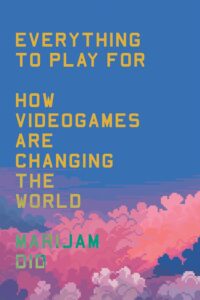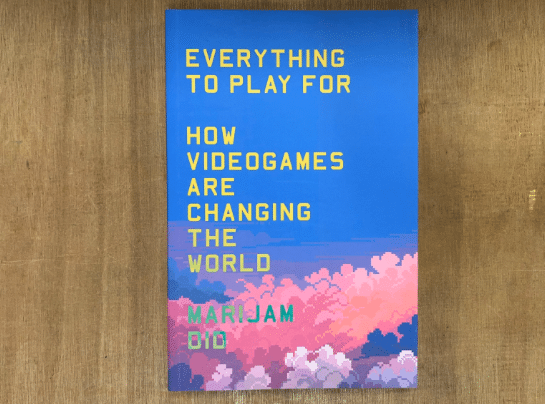Videogames are everywhere. For such a ubiquitous form of media, Marijam Did’s book is a long overdue introduction into the politics of games and their radical potential. Everything to Play For is an accessible overview of the topic, part love letter to the medium, part theoretical intervention, part powerful polemic against some of the most persistent problems in videogames. Did’s writing is incisive and layered, with the occasional memoir-like moment.

Everything to Play For: How Videogames Are Changing the World Author: Marijam Did
Bibliographic information: London: Verso Books, 288 pp., £16,99
ISBN: 9781804293249
Early on, Did articulates an argument for her use of ‘videogame,’ rather than the OED’s ‘video game’. This review uses Did’s spelling and her argument that videogames are “much more than ‘video’ in their technology and much more than ‘games’ in their content” (1). The first substantive chapter provides a historical account of the development of computing, and the issue of the exclusion of women, particularly Black women, is analysed and connected to videogames’ persistent problem with misogyny, both by consumers and developers. This focus is important as it treats representation in an anti-capitalist sense—as a labour issue and as a papering over of capitalist exploitation. Moreover, a key event to the solidification of videogames as commodities, which are marketed almost exclusively to male consumers, is the 1983-5 crash. Drawing on the work of journalist Tracy Lien, Did points out that the financial crash was linked to gaming companies, such as Atari, who shut down their factories in California and Limerick in order to exploit cheaper labour in Hong Kong and Taiwan. Did continuously brings attention to videogames as complex pieces of media, with their own histories of production, and thus place within the global value chain of capitalism. This, in turn, brings an emphasis on the need to take videogames seriously as focal points of specific labour struggles and global chains of production, extraction, and trade. The history chapter also covers the dominance of the first-person shooter in the 1990s and state actors’ co-optation of the nascent genre. She notes that the Pentagon is reported to have spent $150 million in 1999 alone on military-themed games (50). A clear example of this is the 2002 America’s Army, which the Pentagon referred to as a ‘strategic communication device’ with the explicit target of recruitment for the US Army and a marketing budget of $50 million.
In the next chapter, Did examines the problem of school shootings and videogames, with examples such as Super Columbine Massacre RPG!. Did addresses the double standard of wider culture’s treatment of videogames as lesser cultural artifacts that are rarely awarded critical acclaim otherwise afforded to film such as the acclaim for Gus Van Sant’s Elephant. Did then tackles the problems of violence, misogyny and colonialism in videogames, while also engaging with the question of what a political game is, and the adjacent problems around pursuing political narratives. She emphasises that violence tends to come from the communities of players rather than games themselves. The representation of women in videogames is problematised along trends in focusing on women characters who are enmeshed in colonial endeavours (Lara Croft in the Tomb Raider series), espionage and imperialism (Chun-Li in the Street Fighter series) or as victims of violence (Life is Strangeseries). Did refuses to treat representation uncritically and continuously makes the important argument that videogames are complex media, itself interwoven in multiple communities and practices. Violence is likewise problematised: examples range from it being a vehicle for competition to a political message that seeks to provide the player catharsis by putting the player in the midst of the Israeli occupation of Palestine (Under Ash, 2001). All the while, Did refuses to treat videogames as a surefire incentive to violence, but rather as complex, symbolic practices that generate their own subcultures and meaning-making.
This, in turn, sets up the subsequent chapter focusing on gaming communities. Did touches on many examples of gamers who treat virtual worlds as full-fledged social worlds. Examples include MMORPGs such as World of Warcraft and its loot distribution system’s effect on the economic distribution mechanisms manifest in the videogame’s guilds. Other examples include virtual uprisings in Ultima Online (1997) and the use of boycotting tactics. For example, Hogwarts Legacy is a 2023 action role-playing game set in the Harry Potter universe, in which the plot revolves around fighting against a goblin uprising. This, together with criticism of JK Rowling’s use of antisemitic tropes in the portrayal of the goblins as well as Rowling’s vocal transphobia, sparked debate and provoked many gamers to boycott the game. This is significant as it demonstrates the political significance of videogames for inspiring political action, while also providing contrast to the dominant right-wing tactic of negative review spamming—the systematic effort to lower a game’s review scores. The book evocatively summarises the forms of dissent manifest within game worlds: ‘A Gamergater is closer to a 2021 Capital rioter than to an Ultima Online looter, who is closer to a Tottenham rioter, who is closer to an anti-fascist demonstrator’ (117). The chapter also includes examples of gamers as agents (the GameStop short squeeze) and as activists (e.g. neo-Nazi networks on Minecraft are counterposed with large-scale collaborative projects seeking to advocate freedom of the press). Ultimately, Did does well to illustrate the multiple ways in which videogames are spaces for political expression. She never forgets, however, to demonstrate the ways in which currently existing gameworlds often rely on the exploitation of immaterial labour.
In chapter 4, Did explores videogames’ capacity to influence social change. The question is posed in terms of efficacy: how do (or could) videogames subvert, inform or challenge the existing social order and its problems. To do this, Did treats videogames as contemporary art and draws on a range of sources such as French sociologist Pierre Bourdieu and draws comparisons to Swedish curator Maria Lind. Other comparisons include Agnes Denes’ installation Wheatfield (1982), Laura Keeble’s Idol Worship (2007) and Pilvi Takala’s Close Watch hosted at the Venice Biennale in 2022. The chapter treats games as serious objects of art and by doing so likens them to spectacular art projects that obscure labour exploitation and increase the artist’s status and material wealth. Did also touches on examples of videogames as instances of political art (e.g. Papers, Please or You are Jeff Bezos, 2018). This poses the open-ended question of what do videogames that are more than just a political statement look like. The chapter ends evocatively with a bleak invocation of Theodor W. Adorno on the matter of entertainment – ‘videogames are a classic expression of the capitalist modus operandi’ (176). Again and again, Did emphasises an important distinction – unpacking games’ narratives can only get us so far, it is even more important to understand the medium as multilayered, globally interconnected sites of struggle. This argument is important as it directs us to think beyond representation of issues in media and to critically examine the systems that allow for the enrichment of artists and game developers to build their reputation as socially conscious creators without doing anything to challenge the realities they represent in their work.
The final chapter focuses on how games are made. Did discusses the dominance of game engines such as Unreal and Unity, while also covering working conditions in AAA games. The matter of exploitative labour practices such as crunch is not ignored, but Did also takes a moment to acknowledge racism and sexism (among other forms of discrimination) being significant factors for poor working conditions. Another aspect is the sudden and mass layoffs, of which have been a few more since the book’s publication. Throughout the book as a whole, Did maintains her argument with an eye to the periphery of Western Europe’s economy of games production and consumption. For instance, she highlights the example of quality assurance (QA) work being both an entry point into the profession, as well as something that tends to be outsourced to Eastern Europe and the Global South. The focus on working conditions mentions the rising prominence of unions under the umbrella of Game Workers Unite. After the production of videogames, Did turns her attention to curation, or the publishing of a videogame. This section outlines the relationship between developers and publishers, as well as the pattern of consolidation for larger companies opting for self-publishing. Also mentioned are distribution platforms such as Epic and Steam, touching on both their ownership and their extortionate commissions (Steam taking 30% of revenue for the first $10 million in sales). The following section covers the videogames’ reach with esports being a prominent example with the added pitfalls of corruption, nepotism, and doping. From time to time, Did takes brief moments to oppose the hyper-capitalist developments she criticises with images of what could be different. One such example comes in this section, where she evokes the image of Eastern European university halls LAN (local area network) parties as spaces of community and radical potential for an alternative world for videogames. In the final section to the chapter, Did highlights the problem of waste that accompanies such an expansive field of production and consumption. But also, the effects of this cycle of production are emphasised especially in relation to the Global South with examples such as extractive mining practices in the Democratic Republic of Congo (DRC). An often-under emphasised aspect of videogames is not just the waste produced, but the energy consumption involved. Did’s general approach tends to be one of breadth, rather than depth. While this is by no means a detriment and it fits with what appear to be the goals of the book, there are plenty of opportunities for relating an issue to wider bodies of literature. One example of this is that Did clearly situates videogames as a significant node within the global network of imperialism, even though she only seems to use the term itself as a stand-in for military conquest.
The book ends with the aptly titled ‘Final Boss: Conclusion’ chapter. Did raises the question of the totality of global capitalism in the form of a videogame – namely, how it is produced. By doing so, she poses the important follow-up question of how production of videogames could look like for game developers organised differently from the dominant exploitative model. There are, Did argues, ‘so many facets to unpick, underline, revolutionise’ (233). Everything to Play For powerfully portrays videogames as reflective of the social context in which they are produced, curated, experienced, and shared. The book is an open challenge for radical politics by highlighting the multiple ways that games, gaming and gamers constitute a front for the struggle for a better future.

